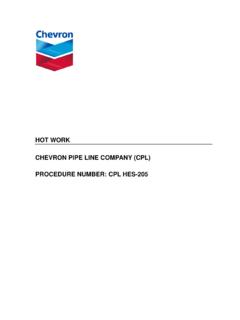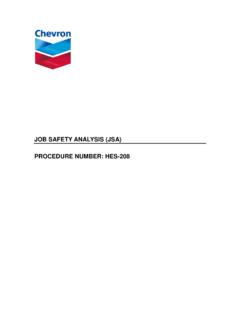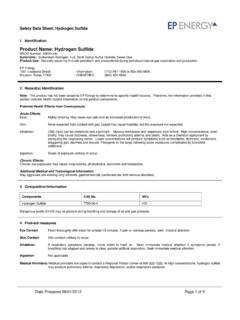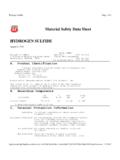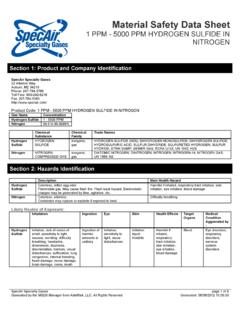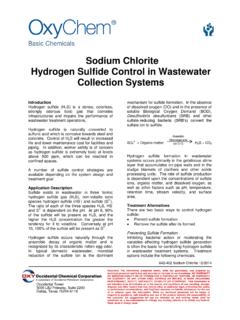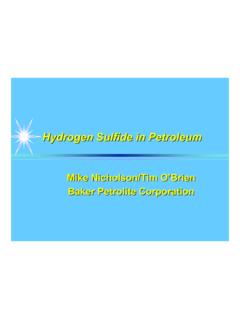Transcription of CPL – Hydrogen Sulfide Procedure HES 211
1 CPL Hydrogen Sulfide Procedure HES 211. Reviewed/Revised January 2012. CPL Hydrogen Sulfide Procedure Table of Contents Purpose, Objectives and 3. Purpose .. 3. 3. Scope .. 3. Requirements .. 3. Terms and Definitions .. 3. Roles, Responsibilities and Training 4. Initial Training .. 4. Refresher Training .. 5. Standard Instructions .. 5. Process Overview .. 5. General 6. Detecting and Monitoring Hydrogen Sulfide .. 6. Warning Systems .. 7. Respiratory Protection .. 7. Other Protective Equipment .. 8. Records .. 8. Required Records .. 8. Retention Requirements.
2 9. References .. 9. Other Guidance Documents .. 9. Document Control .. 10. Appendix A: Training .. 11. Version 1. Revised 14 December 2011 ii Printed January 2012 Uncontrolled when printed. 6-CPL Hydrogen Sulfide Control CPL Hydrogen Sulfide Procedure Purpose, Objectives and Scope Purpose The purpose of this Procedure is to ensure that effective safe work practices are used to protect the workforce from occupational exposure to Hydrogen Sulfide (H2S). Objective The objective of this Procedure is to establish the requirements for the recognition and control of H2S, and to comply with Chevron expectations, federal Occupational Safety and Health Administration (OSHA) regulations 29 CFR Part 1910 for respiratory protection and air contaminants, and related state OSHA standards where applicable.
3 Scope This Procedure covers work performed by Chevron Pipe Line (CPL) employees and their delegates and contractors within CPL operational control. Specifically, this Procedure applies to all personnel, company and contractor, at Chevron Pipe Line (CPL) owned, operated, or maintained facilities where an exposure to airborne H2S at or above 5 parts per million (ppm) may occur. Use of this Procedure is required when any of the following activities are conducted in an area where H2S could be present: Entry into confined spaces Manual tank gauging Commodity sampling Barge loading and unloading Line repair Leak response Operating process equipment and vessels in areas where H2S is known to be or may be present Other activities which H2S monitoring has determined H2S in concentrations of 5 (ppm) or above is present Requirements Terms and Definitions The following terms and definitions apply to this Hydrogen Sulfide Procedure .
4 CVX Hydrogen Sulfide Exposure Standard Exposure limits, work practices and training requirements determined to standardize work place measures used to protect employees and contractors from risks involving actual or potential Hydrogen Sulfide exposures. Fixed Hydrogen Sulfide Monitor A continuous sensor mounted in a specific location to provide rapid detection of Hydrogen Sulfide presence for leak detection purposes or personal or community protection. CPL Hydrogen Sulfide Procedure Immediately Dangerous to Life or Health (IDLH) - An atmospheric concentration that poses an immediate threat to life or would cause irreversible or delayed adverse health effects or would interfere with an individual's ability to escape from a dangerous atmosphere Personal Hydrogen Sulfide Monitor A continuous monitor worn by personnel in or near their breathing zone intended to provide early detection and warning (audible and visual) of the presence of Hydrogen Sulfide equal to or in excess of 5 ppm.
5 SCBA A self contained, air supply respirator worn by individuals in high respiratory hazard environments. Roles, Responsibilities and Training Requirements The following roles and responsibilities pertain to this Procedure : Management provides visible leadership to ensure HES policies and procedures are fully implemented. Team Member must do the following: Follow the H2S requirements for their work areas as explained by their team leader and described within this Procedure . Team Leader must do the following: Ensure that all personnel are knowledgeable of the H2S requirements for the areas in which they work Inform all personnel of the locations where H2S may be expected Ensure that all monitoring is completed Ensure all warning systems are posted, mounted, or labeled, as appropriate HES Team must do the following.
6 Assist with monitoring by providing information, instruction, or direct assistance at the work site Assist with the selection, location, and usage of fixed monitoring systems Coordinate the development and revisions to this Procedure Coordinate the implementation and training of this Procedure Initial Training Employees who work in areas where the potential for exposure to H2S at 5 ppm or greater, must be informed of the hazards of H2S exposure, symptoms of overexposure, use of respiratory protection equipment, and special precautions to minimize exposure, and shall be trained in the hazards associated with H2S and the use of personal protective equipment.
7 Trained employees shall: Demonstrate knowledge of the hazards of H2S. Comply with the provisions of this and other applicable procedures Properly use and maintain personal protective equipment Reviewed/Revised January 2012 4. Printed January 2012 Uncontrolled when printed. CPL Hydrogen Sulfide Control HES 211. CPL Hydrogen Sulfide Procedure Demonstrate knowledge of site-specific operations/contingency plan procedures , if applicable Refer to Appendix A for details of training requirements. Refresher Training Refresher training must be provided as follows: As required by applicable regulations or SBU policy or process safety standards As needed when identified by: verification, inspections, incidents or audits Standard Instructions Process Overview Is there a potential This Procedure does for atmospheric H2S No not apply.
8 In the work area? Yes Personal/Portable Is H2S <5 ppm? Yes H2S monitor required for all work. No Personal/portable monitor required for all work. H2S signs required at equipment. Refer to CVX standard for H2S is >100 ppm? Yes management of IDLH hazards and associated PPE requirements Reviewed/Revised January 2012 5. Printed January 2012 Uncontrolled when printed. CPL Hydrogen Sulfide Control HES 211. CPL Hydrogen Sulfide Procedure General Instructions A method of protecting employees from exposure to work-area atmospheric concentrations of H2S equaling or exceeding 5 ppm shall be provided.
9 Acceptable methods include, but are not limited to, the following: Requiring all personnel to wear proper and fully functioning supplied air respiratory protection equipment before entering the area Installing fixed H2S monitoring equipment Using personal H2S monitors Properly ventilating the facility to maintain H2S concentrations in the work area atmosphere less than 5 ppm, confirmed by continuous monitoring Testing the facility before entry and continuously while in the facility using portable H2S detection equipment to verify that H2S concentration in the work-area atmosphere does not exceed 5 ppm Detecting and Monitoring Hydrogen Sulfide 1.
10 If a material specific Material Safety Data Sheet is not available for a produced oil or gas stream, testing for the presence of H2S must be done for each new type of material soon after it has been received so that the degree of hazard can be assessed. Affected employees shall be advised of monitoring results and what precautions must be taken. Refer to the Chevron Hydrogen Sulfide Exposure Standard and CPL Exposure Assessment Procedure for instructions. 2. Continuous fixed monitoring systems are used to constantly measure the concentration of H2S in the atmosphere.
